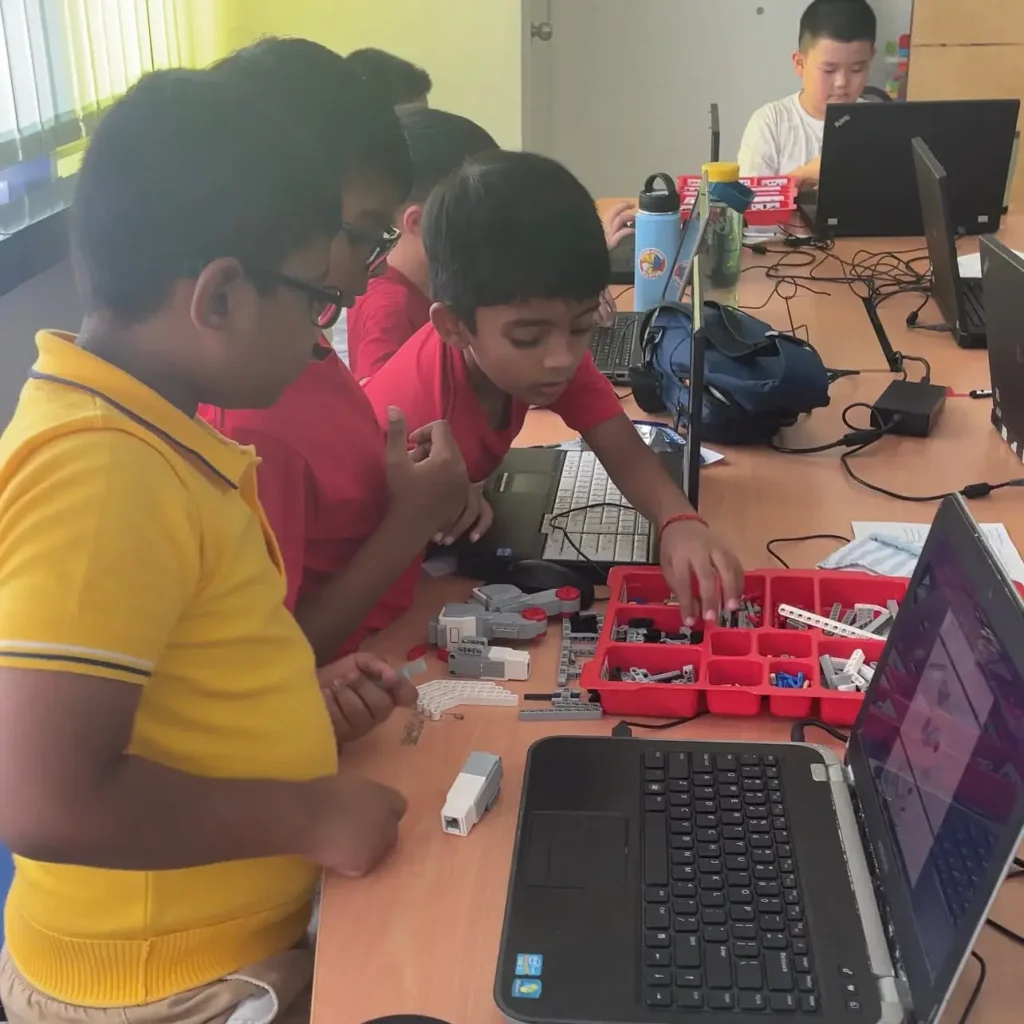Hey there! Whether you’re a busy mom juggling a million tasks or a professional looking to upskill, I’ve got something exciting to share. Picture this: your child confidently explaining a game they built to their friends, or you nailing a work presentation with crystal-clear ideas. Sounds awesome, right? Well, coding can unlock these communication superpowers—for your kids and for you! And if you’re wondering how to help shy child communicate better, coding might just be the secret weapon you’re looking for.
As a coding trainer at Advaspire Robotics & Coding Academy, and I’ve seen firsthand how coding transforms not just tech skills but also the way we communicate. It’s not just about writing lines of code; it’s about learning to express ideas, work with others, and even connect globally. So, let’s dive into how coding can boost communication skills in ways you might not expect—especially to help shy child communicate better. And stick around—I’ll share some stories from my classes that’ll make you smile! If you’re new to coding and looking for a starting point, check out my guide on How to Introduce Coding to Your 7-Year-Old: Beginner Tips.
How Coding Can Help Shy Child Communicate Better Fast

Breaking Down Complex Ideas into Simple Steps
Coding Teaches You to Think Clearly
One of the coolest things about coding is how it forces you to break down big, messy problems into bite-sized pieces. Think of it like explaining your favorite recipe to your child: you don’t just say, “Make spaghetti!” You break it down—boil the water, cook the pasta, add the sauce. Coding works the same way. When you write a Python program, like a simple calculator, you have to think step-by-step: get the numbers, choose the operation, show the result.
This skill translates directly to communication. When your child learns to organize their thoughts logically through coding, they get better at explaining ideas clearly. I’ve seen this in action at Advaspire. One of my students was super shy at first. She’d mumble when asked to explain her robotics project. But after a few weeks of coding her robot to follow a maze, she started breaking down her process for the class: “First, I tell the robot to go forward, then check for walls…” Her confidence in explaining things soared, and now she’s the first to volunteer to present! This is a perfect example of how coding can help shy child communicate better by giving them a structured way to express their ideas. This structured thinking also ties into problem-solving—learn more in my post on How Coding Can Enhance Problem-Solving Skills in Kids.
Why It Matters for You and Your Kids

Collaborating Through Code—Teamwork Makes the Dream Work
Working Together Builds Communication Skills
Coding isn’t a solo sport—well, not always! A lot of projects, especially the fun ones, involve teamwork, which is a fantastic way to practice communication. At Advaspire, we often have group projects where kids team up to build something cool, like a game in Unity. They have to share ideas, divide tasks, and give each other feedback. It’s like planning a school bake sale with your kids: everyone has a role, and you need to talk it out to make it work.
I remember a group of three kids last year who wanted to create a racing game. One was great at designing the cars, another loved coding the movement, and the third was a whiz at adding sounds. At first, they struggled—there was a lot of, “No, I want it this way!” But as they worked together, they learned to listen, explain their ideas, and compromise. By the end, they were high-fiving and proudly showing off their game to the class, explaining who did what and why. That’s communication in action! For a shy child, this collaborative environment can really help shy child communicate better by encouraging them to speak up and share their ideas in a supportive setting. If you’re looking for more ways to make coding fun and collaborative, my post on 12 Coding Games That Will Make Learning Fun and Easy for Your Kids!
How This Helps in Everyday Life

Building Confidence to Express Ideas
Creating Something Tangible Boosts Confidence
There’s something magical about coding: you start with a blank screen, and by the end, you’ve created something real—like a game, a robot, or even a chatbot. That sense of accomplishment does wonders for confidence, and confident people are better communicators. When you know you’ve built something cool, you can’t wait to share it with others.
Take my student for example. He was a quiet 8-year-old who barely spoke in class. We worked on a simple Tic-Tac-Toe game in Scratch. When he finished, he was beaming—he’d made a game where you could click to place X’s and O’s! At our next session, he volunteered to show the class how it worked, explaining each step with a huge smile. That project gave him the confidence to speak up, and now he’s always eager to share his ideas. This shows how coding can help shy child communicate better by giving them the confidence to express themselves without fear.
Why Confidence Matters for Communication

Debugging as a Lesson in Patience and Clarity
Asking for Help the Right Way
Let’s be real: coding isn’t always smooth sailing. You’ll run into bugs—those pesky errors that make your program crash. But debugging is a hidden gem for communication skills. When something goes wrong, you have to figure out how to explain the problem clearly to get help, whether it’s from a teacher, a friend, or even an online forum.
I’ll never forget the time I was helping a student debug her Python code. She was trying to make a chatbot, but it kept giving weird responses. She came to me frustrated, saying, “It’s broken!” I asked her to explain exactly what was happening, and after a few tries, she said, “When I type ‘hi,’ it says ‘goodbye’ instead of ‘hello.’” That clarity helped us find the issue—a simple typo in her code. That moment taught her how to ask for help in a way that gets results, and now she’s great at explaining problems, whether it’s in coding or at school.
Patience Pays Off in Communication

Coding as a Universal Language
Connecting Across the Globe
Here’s something I love about coding: it’s a universal language. Whether you’re in Malaysia or halfway across the world, code speaks the same language. This means coding can help you connect with others, no matter where they’re from, which is a powerful communication skill in today’s global world.
At Advaspire, we encourage our students to share their projects online—like on Scratch. One of my students, uploaded a simple game she made in Scratch. A kid from Korea commented on it, giving her feedback in broken English. She was thrilled! She replied with tips on how she coded the game, and they ended up chatting about their favorite games. That exchange taught her how to communicate across cultures, all because of coding.
Why This Matters for You and Your Kids
For kids, this global connection is like making friends through a shared hobby—it opens their world and teaches them to communicate with people who are different from them. For you, it’s like networking with professionals globally, whether you’re coding as a hobby or for work. Coding breaks down barriers and helps you build communication skills that work anywhere. This global perspective also prepares them for future opportunities—learn why in my post on 8 Reasons Coding as a Pathway to Future Career Opportunities.

Bonus: Coding Encourages Active Listening
Listening to Understand, Not Just to Respond
One more way coding boosts communication? It teaches active listening. When you’re working on a project with someone else—or even following a tutorial—you have to really listen to understand what’s going on. If your teammate says, “I think we should add a jump button to the game,” you need to listen to their reasoning, not just nod and move on.
I learned this myself when I started teaching. Early on, I had a student who kept saying his robot wasn’t moving right. I’d jump in with solutions without fully listening. One day, I slowed down and asked him to explain exactly what he meant. Turns out, he’d coded the robot to turn left instead of right—a simple fix! That taught me to listen better, and now I see my students doing the same when they work together. Active listening is a communication skill that coding naturally builds, and it’s so useful in everyday life.
How This Helps You and Your Family
Let’s Get Coding—and Communicating!
So, there you have it! Coding isn’t just about tech—it’s a fantastic way to boost communication skills. It helps you break down ideas, work as a team, build confidence, practice patience, connect globally, and even listen better. Whether you’re looking to help shy child communicate better or grow your own skills, coding has something amazing to offer.
At Advaspire Robotics & Coding Academy, I’ve seen kids transform through coding. They start shy, and by the end, they’re confidently sharing their projects and ideas. It’s such a joy to watch! If you’re curious to try it out, why not join us for a trial session this Sunday? We’ve got fun classes in Python, Unity, and robotics that’ll get you or your child coding—and communicating—like a pro. Not sure if we’re the right fit? My post on 9 Expert Tips for Choosing the Best Enrichment Centre for Your Child’s Growth and Learning.
Drop by our center or DM me to sign up. Let’s build those communication superpowers together! As a mom or a professional woman, you’re already a communicator—coding just makes you and your child even better at it.